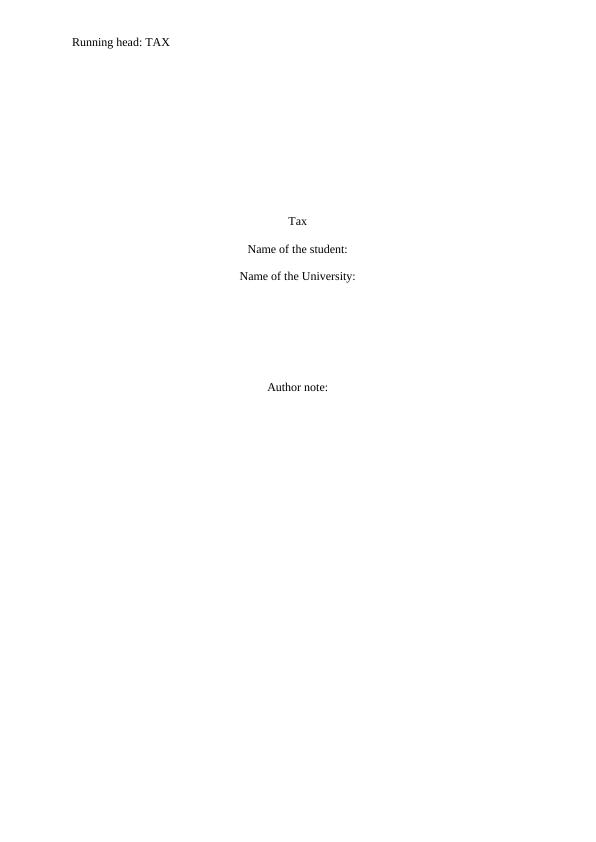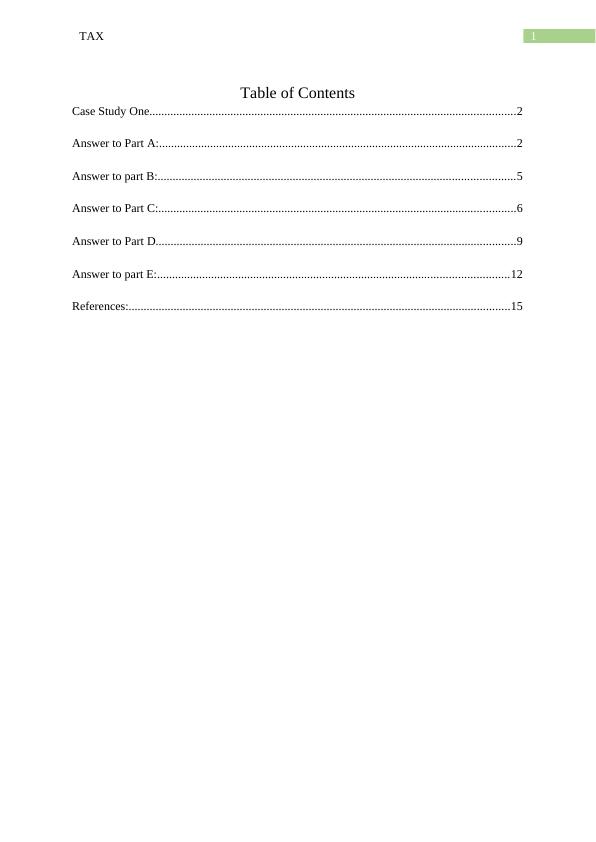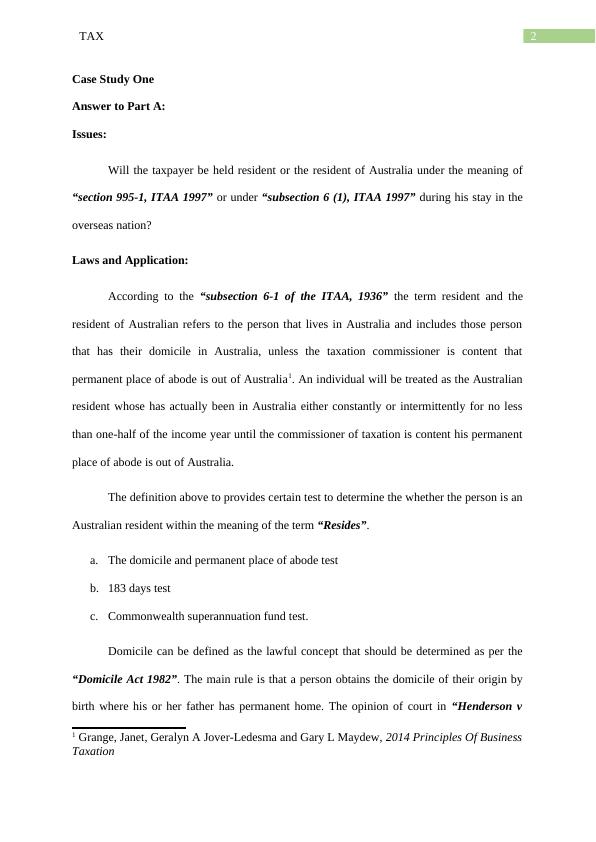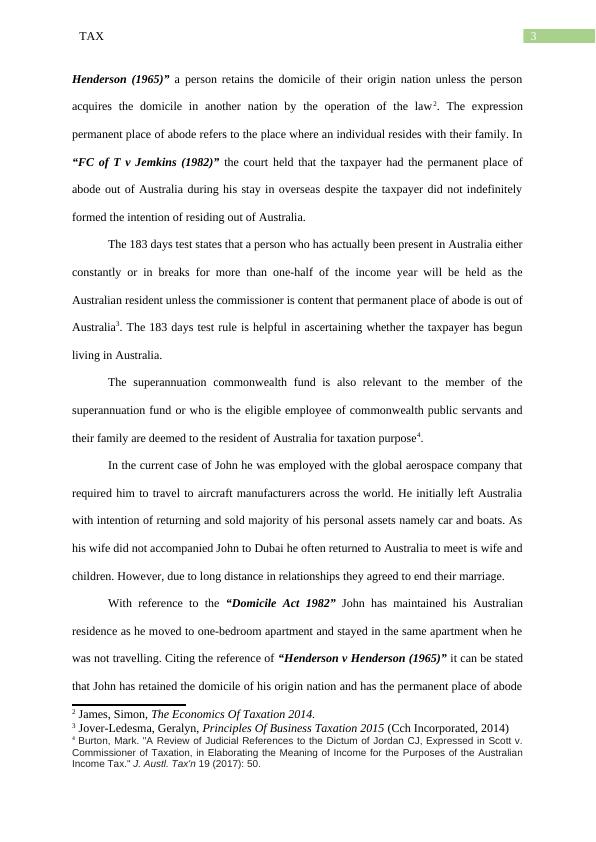Tax Case Study and Analysis
Added on 2023-06-07
18 Pages5298 Words195 Views
Running head: TAX
Tax
Name of the student:
Name of the University:
Author note:
Tax
Name of the student:
Name of the University:
Author note:

1TAX
Table of Contents
Case Study One..........................................................................................................................2
Answer to Part A:.......................................................................................................................2
Answer to part B:.......................................................................................................................5
Answer to Part C:.......................................................................................................................6
Answer to Part D........................................................................................................................9
Answer to part E:.....................................................................................................................12
References:...............................................................................................................................15
Table of Contents
Case Study One..........................................................................................................................2
Answer to Part A:.......................................................................................................................2
Answer to part B:.......................................................................................................................5
Answer to Part C:.......................................................................................................................6
Answer to Part D........................................................................................................................9
Answer to part E:.....................................................................................................................12
References:...............................................................................................................................15

2TAX
Case Study One
Answer to Part A:
Issues:
Will the taxpayer be held resident or the resident of Australia under the meaning of
“section 995-1, ITAA 1997” or under “subsection 6 (1), ITAA 1997” during his stay in the
overseas nation?
Laws and Application:
According to the “subsection 6-1 of the ITAA, 1936” the term resident and the
resident of Australian refers to the person that lives in Australia and includes those person
that has their domicile in Australia, unless the taxation commissioner is content that
permanent place of abode is out of Australia1. An individual will be treated as the Australian
resident whose has actually been in Australia either constantly or intermittently for no less
than one-half of the income year until the commissioner of taxation is content his permanent
place of abode is out of Australia.
The definition above to provides certain test to determine the whether the person is an
Australian resident within the meaning of the term “Resides”.
a. The domicile and permanent place of abode test
b. 183 days test
c. Commonwealth superannuation fund test.
Domicile can be defined as the lawful concept that should be determined as per the
“Domicile Act 1982”. The main rule is that a person obtains the domicile of their origin by
birth where his or her father has permanent home. The opinion of court in “Henderson v
1 Grange, Janet, Geralyn A Jover-Ledesma and Gary L Maydew, 2014 Principles Of Business
Taxation
Case Study One
Answer to Part A:
Issues:
Will the taxpayer be held resident or the resident of Australia under the meaning of
“section 995-1, ITAA 1997” or under “subsection 6 (1), ITAA 1997” during his stay in the
overseas nation?
Laws and Application:
According to the “subsection 6-1 of the ITAA, 1936” the term resident and the
resident of Australian refers to the person that lives in Australia and includes those person
that has their domicile in Australia, unless the taxation commissioner is content that
permanent place of abode is out of Australia1. An individual will be treated as the Australian
resident whose has actually been in Australia either constantly or intermittently for no less
than one-half of the income year until the commissioner of taxation is content his permanent
place of abode is out of Australia.
The definition above to provides certain test to determine the whether the person is an
Australian resident within the meaning of the term “Resides”.
a. The domicile and permanent place of abode test
b. 183 days test
c. Commonwealth superannuation fund test.
Domicile can be defined as the lawful concept that should be determined as per the
“Domicile Act 1982”. The main rule is that a person obtains the domicile of their origin by
birth where his or her father has permanent home. The opinion of court in “Henderson v
1 Grange, Janet, Geralyn A Jover-Ledesma and Gary L Maydew, 2014 Principles Of Business
Taxation

3TAX
Henderson (1965)” a person retains the domicile of their origin nation unless the person
acquires the domicile in another nation by the operation of the law2. The expression
permanent place of abode refers to the place where an individual resides with their family. In
“FC of T v Jemkins (1982)” the court held that the taxpayer had the permanent place of
abode out of Australia during his stay in overseas despite the taxpayer did not indefinitely
formed the intention of residing out of Australia.
The 183 days test states that a person who has actually been present in Australia either
constantly or in breaks for more than one-half of the income year will be held as the
Australian resident unless the commissioner is content that permanent place of abode is out of
Australia3. The 183 days test rule is helpful in ascertaining whether the taxpayer has begun
living in Australia.
The superannuation commonwealth fund is also relevant to the member of the
superannuation fund or who is the eligible employee of commonwealth public servants and
their family are deemed to the resident of Australia for taxation purpose4.
In the current case of John he was employed with the global aerospace company that
required him to travel to aircraft manufacturers across the world. He initially left Australia
with intention of returning and sold majority of his personal assets namely car and boats. As
his wife did not accompanied John to Dubai he often returned to Australia to meet is wife and
children. However, due to long distance in relationships they agreed to end their marriage.
With reference to the “Domicile Act 1982” John has maintained his Australian
residence as he moved to one-bedroom apartment and stayed in the same apartment when he
was not travelling. Citing the reference of “Henderson v Henderson (1965)” it can be stated
that John has retained the domicile of his origin nation and has the permanent place of abode
2 James, Simon, The Economics Of Taxation 2014.
3 Jover-Ledesma, Geralyn, Principles Of Business Taxation 2015 (Cch Incorporated, 2014)
4 Burton, Mark. "A Review of Judicial References to the Dictum of Jordan CJ, Expressed in Scott v.
Commissioner of Taxation, in Elaborating the Meaning of Income for the Purposes of the Australian
Income Tax." J. Austl. Tax'n 19 (2017): 50.
Henderson (1965)” a person retains the domicile of their origin nation unless the person
acquires the domicile in another nation by the operation of the law2. The expression
permanent place of abode refers to the place where an individual resides with their family. In
“FC of T v Jemkins (1982)” the court held that the taxpayer had the permanent place of
abode out of Australia during his stay in overseas despite the taxpayer did not indefinitely
formed the intention of residing out of Australia.
The 183 days test states that a person who has actually been present in Australia either
constantly or in breaks for more than one-half of the income year will be held as the
Australian resident unless the commissioner is content that permanent place of abode is out of
Australia3. The 183 days test rule is helpful in ascertaining whether the taxpayer has begun
living in Australia.
The superannuation commonwealth fund is also relevant to the member of the
superannuation fund or who is the eligible employee of commonwealth public servants and
their family are deemed to the resident of Australia for taxation purpose4.
In the current case of John he was employed with the global aerospace company that
required him to travel to aircraft manufacturers across the world. He initially left Australia
with intention of returning and sold majority of his personal assets namely car and boats. As
his wife did not accompanied John to Dubai he often returned to Australia to meet is wife and
children. However, due to long distance in relationships they agreed to end their marriage.
With reference to the “Domicile Act 1982” John has maintained his Australian
residence as he moved to one-bedroom apartment and stayed in the same apartment when he
was not travelling. Citing the reference of “Henderson v Henderson (1965)” it can be stated
that John has retained the domicile of his origin nation and has the permanent place of abode
2 James, Simon, The Economics Of Taxation 2014.
3 Jover-Ledesma, Geralyn, Principles Of Business Taxation 2015 (Cch Incorporated, 2014)
4 Burton, Mark. "A Review of Judicial References to the Dictum of Jordan CJ, Expressed in Scott v.
Commissioner of Taxation, in Elaborating the Meaning of Income for the Purposes of the Australian
Income Tax." J. Austl. Tax'n 19 (2017): 50.

End of preview
Want to access all the pages? Upload your documents or become a member.
Related Documents
Determining Tax Residency Status under ITAA 1997lg...
|6
|1408
|243
The Taxation Law Assessment 2022lg...
|19
|3873
|22
Taxation Law Questions 2022lg...
|16
|3039
|25
Case Study One Residences 2022lg...
|19
|3755
|60
Taxation Lawlg...
|9
|1949
|445
Advance Taxation: Residency Test and Assessable Income Calculationlg...
|10
|2263
|272
